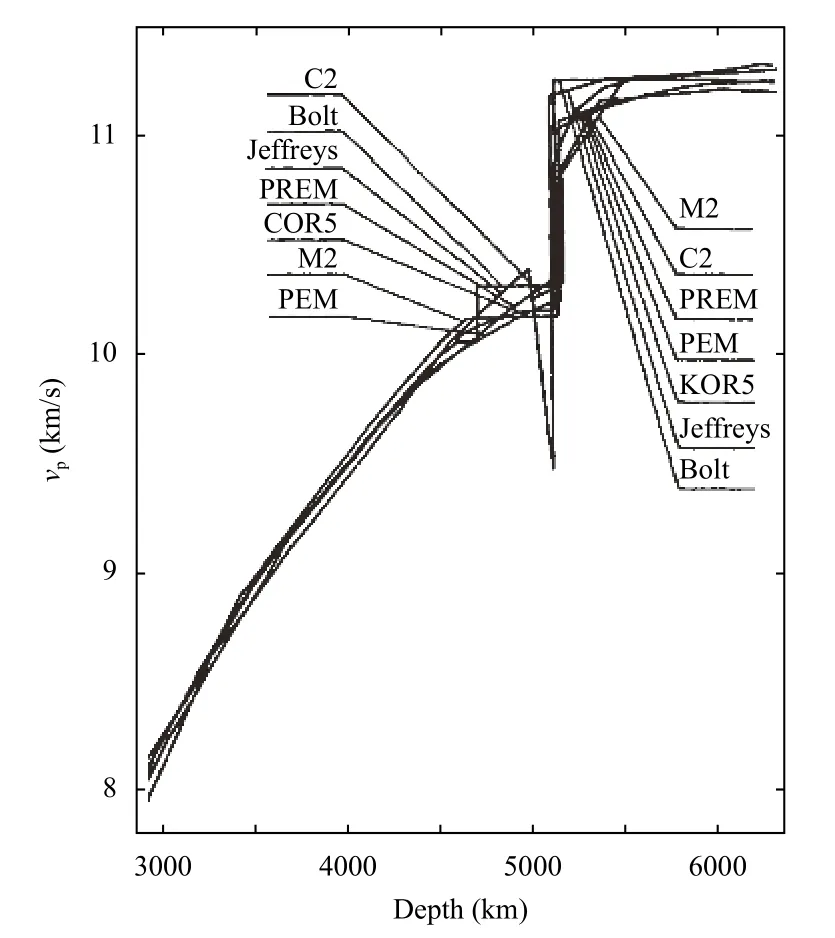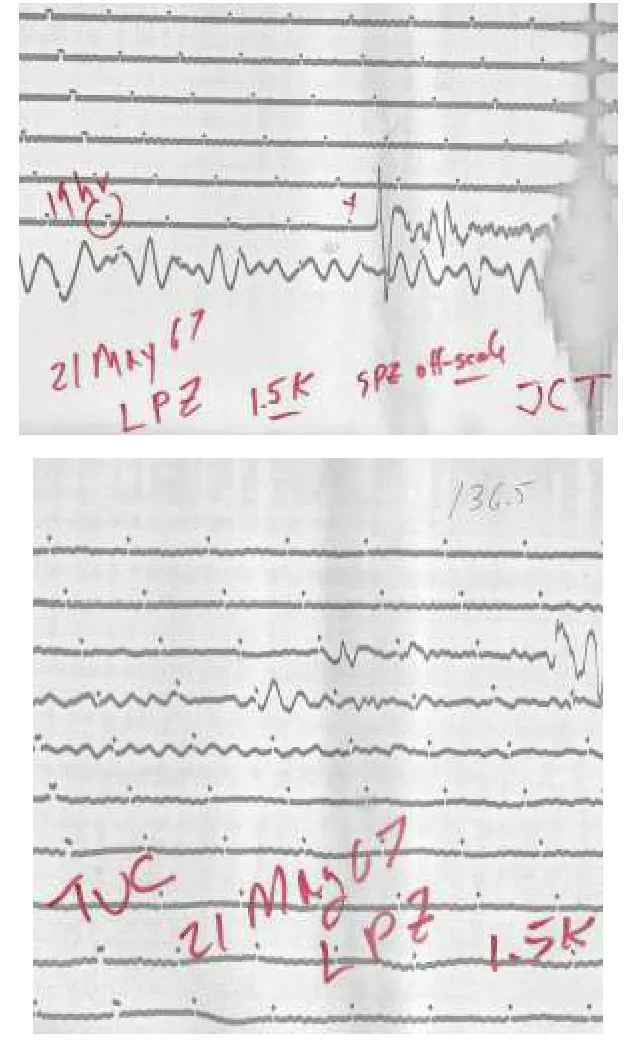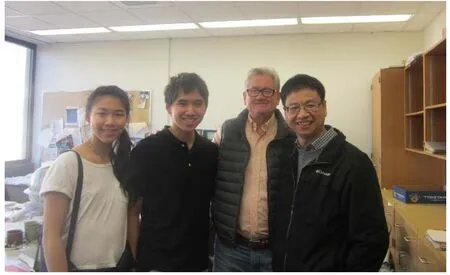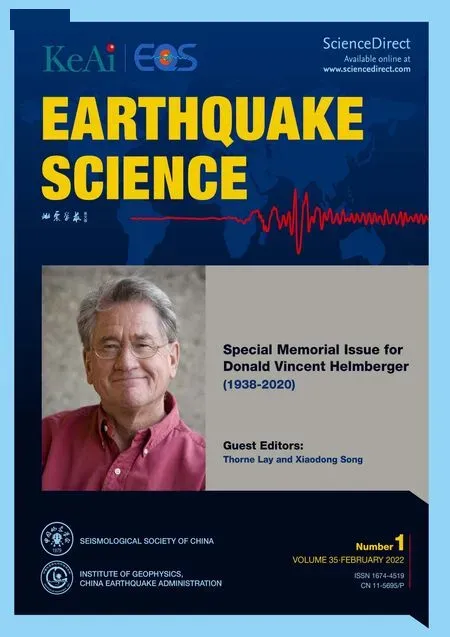My journey to the center of the Earth: A tribute to Professor Donald V. Helmberger
Xiaodong Song
Institute of Theoretical and Applied Geophysics, School of Earth and Space Sciences, Peking University, Beijing 100871, China
It has been more than a year since Don passed away suddenly. Thinking about it still makes my heart hurt. I did not know Don Helmberger or any other famous geophysicists before joining the Seismological Laboratory at Caltech in 1989. In fact, I had barely heard of the Seismo Lab before I landed there, to some extent, by chance or pure luck. At the time, graduate applications were filed by paper. A fellow student gave me a Caltech application form, as he thought he was not good enough,and encouraged me to apply instead. Despite the lack of information at the time and my own ignorance, I took the opportunity. Little did I know, my academic journey had begun at that moment.
Admission
The Seismo Lab received many Ph.D. students from Chinese mainland and Taiwan. An early graduate from the Seismo Lab was Professor Fu Chengyi (Ph.D. 1944;Adviser: Beno Gutenberg), who was probably the first Seismo Lab Ph.D. graduate from China and became one of the founding fathers of geophysics in China upon returning. Over the years, Don trained many students,including more than 20 Chinese students and postdocs,probably the most so far among all the Seismo Lab professors over its 100-year history. The Seismo Lab has also hosted some Chinese visiting scholars throughout this time, including Academician Yao Zhenxing and Professor Zhou Huilan in the earlier years.
Professors Yao and Zhou both wrote letters of recommendation for my application. Prof. Yao was Prof.Fu Chengyi’s graduate student. In the early 1980s, he stayed at the Seismo Lab for 1.5 years working with Don,after staying at the University of Southern California for 1.5 years. Don remembered him well and said more than once that he was very smart (he would call him by the last name “Yao”). I did not know Prof. Yao, but he was kind enough to write a letter of recommendation for me after a brief conversation. He was very happy for the fact that the four students he recommended to Caltech were successful afterwards (Lianshe Zhao, Ph.D. 1991, Lianxing Wen,Ph.D 1998, Chen Ji, Ph.D. 2002, besides myself, who were all Don’s students).
Prof. Zhou was my undergraduate teacher at the University of Science and Technology of China. She stayed at the Seismo Lab for two years working mainly with Hiroo Kanamori and Clarence Allen. Somehow, she had a very good impression of me, giving me opportunities and offering advice. Thus, when I was struggling at deciding which school to accept, she had a strong sway in my decision. In our recent phone conversation, she recalled her fond memories at the Seismo Lab and some of the thoughts on my choice at the time. She felt I knew what I wanted to do. I seemed to be the “academic type”and I was interested in seismic waves. “I didn’t know whether it’s the best place, but it would be a great place for studying seismology” she remarked on Caltech. It’s also very easy to access seismic data. She recalled using the film chip records of the World-Wide Standardized Seismograph Network (WWSSN) in the Seismo Lab basement. The Seismo Lab also has a history of building and operating seismic networks. Thus, she thought Caltech would be a great match for me.
On July 7, 1989, I arrived at Caltech. It was a Friday afternoon after work, time for the Division beer gathering at the back yard of the South Mudd Building. Lianshe picked me up at LAX (Los Angles International Airport)and we went straight there, where I instantly found that my earlier practice of oral English was quite useful in helping adapt to the new life. As I arrived early, I was supported by Clarence Allen for the summer months before the Fall quarter started. Prof. Allen was an old friend to Chinese geologists and geophysicists. He served in the Army Air Corps in the Pacific during World War II and visited China many times later on. At the beginning of the Fall semester,I was told that the Run Run Shaw Foundation (of Hong Kong) would offer me a 3-year graduate fellowship (given to only two Caltech graduate students that year), for which I could not think of a good reason except perhaps I did well in my TOEFL exam.
The Seismo Lab
Soon after I joined the Seismo Lab, I realized that(creative) research was the thing that we needed to focus on. Unlike many institutions, students here were not tied to any particular professor or project at the start. To demonstrate the ability to do independent research, a new student in the Seismo Lab must take up two projects with two different faculty members and present the projects in an oral exam at the beginning of the second year.
One of the projects I did was with Don. It was to look at PKP waves (P waves passing through the core). The initial idea was to study the P wave structure at the D”region (lowermost ~200 km of the mantle). At the time,studies on D” had focused on S waves, including the initial work by Lay and Helmberger (1983), which first discovered the D” discontinuity (also known as the Lay-Helmberger discontinuity). Studies on P structure had been lacking.
PKP waves are sensitive to D” structure (Song XD and Helmberger, 1993a, 1997). But we quickly realized that we needed to understand the core first. Unlike SKS, which turns shallowly in the outer core, the PKP waves dive deeper and inevitably enter the inner core. That became my first Ph.D. project and my very first scientific paper(Song XD and Helmberger 1992; SH92). The key issue was that seismic models for the inner core boundary were quite variable (Figure 1). “The variety of models displayed indicates the richness of possible interpretations” (SH92).Figure 1 was later used in the classic textbook by Lay and Wallace (1995). It was a transformative start. I learned what research is about (which I did not really know before joining Caltech) and how it is carried out in the normal process (finding a problem, working out the method,searching for needed data, performing the analyses,drawing conclusions, summarizing the results, and going through the review process).

Figure 1. P velocity models of the Earth’s core compiled by Song XD and Helmberger (1992).
The approach we used is the so-called “waveform modeling”. “It appears that the most detailed resolution of this discontinuity will come from the waveform modeling approach which will be followed in this study. This basic method relies on fitting observations with synthetics based on a model where the wave equations are satisfied”(SH92). Don wrote those quoted sentences in the paper(although he was not known for poetic English writing, I found his writing was always full of sparks of ideas). One tries to find high-quality (which usually means relatively few) record sections to study and to study well.Furthermore, because the deep structure of the Earth is not spherical, it must be sampled accordingly. Thus, a regionalization analysis is undertaken with a detailed investigation of a particular sample of the deep interior.This basic approach was a hallmark of Don’s works,leading to many of his important discoveries (Lay, 2021).Synthetic waveforms need to be generated efficiently in order to adjust the model to fit the observed waveforms in the trial-and-error exercise. Don used synthetics for 1D Earth at the early stage (Helmberger, 1983), the famous Generalized Ray Theory (GRT) codes, and later expanded to 2D (Helmberger et al., 1996; Wen LX and Helmberger,1998; Ni SD et al., 2000) and 3D (Helmberger and Ni SD,2005; Ni SD et al., 2005) synthetics.
The data we used were analog in the beginning years when the new digital seismic stations were just starting to appear. Don enjoyed finding data himself in the basement film chip archive (Figure 2). After a while, I would spend time in the basement too. The digitization software(nXscan) developed in house was a great help and became instrumental for my later studies of inner core temporal changes that rely on historical earthquake data (below).

Figure 2. Examples of seismic record copies from film chips obtained by Prof. Helmberger with his hand-written marks.The records were digitized and included in Song XD and Helmberger (1992).
Don had a natural talent for motivating students. He empowered them in their work and made them feel intelligent. Early on I needed to modify the GRT codes to double precision so that they could be used for the core phases. He would later call the modification “your codes”. At times in our discussion, he would pause for a long time, staring out of the window. I would think I had probably said something dumb, but he would not point it out. His great scientific insights were penetrating and contagious and his genuine appreciation of good science(“terrific”, “good stuff”) boosted your confidence and interest.
Oral exam time came. I had been warned at the very start by senior fellow Chinese students to pay attention and not to “lose face”. Fortunately, my exam went smoothly.David Stevenson asked an interesting question of why I paid attention to the waveform fit at the beginning part of the waveform but not the later part. When we talked later,Don clearly found the question hilarious. He joked that Dave had gotten better — he used to question how a seismologist can make a living solving only the wave equation. Peter Wyllie, the Committee Chair, wrote a short summary letter (which I have kept to this day), stressing the importance of broadening my research scope moving forward. I remember an interesting event around that time,which was a cultural education for me. At an annual Zilchbrau (a party of the Division to mingle and poke fun),graduate students shot a movie of an oral exam scene. The failed candidate got so agitated that he jumped across the table and choked the faculty. It struck me in particular because it was not only well done but also dramatized the stimulating environment of equality (and in a humorous way).
Another skill that all of us picked up was computing.Rob Clayton gave me a copy of Kernighan and Ritchie’s C Programming in early days, alerting me the importance of coding. The Seismo Lab is very open and you learn a lot from your peers. But I took some additional computer science courses and ended up with a Computer Science minor in my Ph.D. Don asked one time: “Do you want to be a scientist or a scholar?”. That was an interesting contrast that I had never thought about before. I certainly didn’t want to be a bookworm. In retrospect, the experience was more useful in managing computational resources and needs in my own group, particularly at the beginning stage, than in my own research.
A Career
广义重心坐标是重心坐标方法在多边形和多面体上的扩展,GBCs函数λk在某一点vk内满足以下4项性质[5,12],
The training from Don and the Seismo Lab had a profound impact on my career. Habits from the training got ingrained into our minds and became part of our DNA.I continued to work on the Earth’s core and to communicate with Don after moving to Lamont-Doherty Earth Observatory of Columbia University.
One of my Ph.D. studies with Don was the confirmation of the existence of the anisotropy of the inner core (Song XD and Helmberger, 1993b). The idea was proposed a while back (in 1986), but had remained controversial. The arrival time picks from the International Seismological Center (ISC) that were used are quite noisy and subject to biases (source errors and mantle heterogeneities); anomalous observations were in fact thrown out as noisy “outliers”. We measured differential times between PKP phases based on actual waveforms,which is more precise and less biased by non-inner core factors, from a global search of paths with different ray directions. Obviously, the waveform-based approach is vastly outnumbered by the ISC data set, but the advantage of the approach is also equally obvious. The model can explain the first arrivals of the inner core phase (DF phase)well. However, the DF waveforms from the famous South Sandwich Islands (SSI) to Alaska and Canada appear unusually broad in the long-period records (Song XD and Helmberger, 1998; Figure 3). We thought the waveform complication in fact resulted from a “baby triplication”,which appears as broad waveforms from the overlapping of multiple arrivals. The triplication is generated due to a velocity jump from the transition of the isotropic upper inner core to the anisotropic lower inner core along the pathway.

Figure 3. Evidence leading to the proposal of an inner core transition zone by Song XD and Helmberger (1998). Note the DF pulses (the beginning ones) from SSI to Alaska are broadened, which can be explained by the synthetics at the right column.
In the work leading to the evidence for inner core super-rotation that Professor Paul Richards and I proposed(Song and Richards, 1996), attention to subtle differences was critical (Figure 4). The care to measure the relative times as precisely as possible helped reduce data scatter in the extraction of the delicate temporal change signal. Some measurements for the critical SSI to College, Alaska path had been made in my Ph.D. study, which made it easier to compare with the data in the early 1990s that were easily accessible at the International Research Institution of Seismology Data Management Center. The idea of overlaying and comparing observed seismograms (Figure 4) was a routine exercise, similar to how we tried to match a synthetic to the observed waveforms. In the follow-up hunt for historical data to confirm temporal changes from the inner core, the skills of working with analog data(finding, scanning, and digitizing the waveforms) in my graduate study became handy, which led me to archives around the world (Palisades, New York, USA; Golden and Denver, Colorado, USA; College, Alaska, USA; Beijing,China; and Tokyo, Japan) (Song XD, 2000; Song XD and Li AY, 2000; Xu XX and Song XD, 2003).

Figure 4. Observation of temporal change of the inner core phase (PKP DF), leading to the proposal of inner core rotation,from Song and Richards (1996). The use of the outer core reference phase, PKP(BC), helps reduce other biases. The 1982 trace is digital data, while the 1967 trace was digitized from the WWSSN analog record.

Figure 5. Don with my son and daughter. The picture was taken in early January 2015 in Don’s office during the holiday break.
My Caltech training has led me to a career that has focused on studies of the Earth’s core for a great part:fruitful years as a postdoctoral fellow and young researcher at Lamont, tenured professor at University of Illinois at Urbana-Champaign, and visiting positions and recent full-time position in China. I’ve received virtually continuous support in this study area over the decades from the U.S. National Science Foundation, the National Natural Science Foundation of China, the U.S. National Aeronautics and Space Administration, and so on. At the heart of the issue is the limited sampling and resolution of the core, particularly the inner core. For half of the century after its discovery, the inner core had been a featureless sphere. However, over the last few decades, it has been shown to be quite complex and mysterious. I was fortunate to start working on this problem at the cusp of important breakthroughs under Don’s mentorship.
Don Forever
Don will always live in my heart as one of the people who influenced my life the most. He introduced me to the wonderful world of science and seismology. As I tell my kids, the American branch of our family started at Caltech.As they grew up, I would pay attention to their interests and passions. My son is now pursuing a science Ph.D. with an interest in academia, a rarity among his peers of similar background. The academic father-like influence that Don had on me impacted the way I tried to guide my kids(Figure 5).
In the current era of “big data”, full-waveform inversion and machine learning are the fashion, where a large amount of data are thrown in a “black box”. Details and subtle differences in the waveforms can get buried easily in the global averaging and optimization. However,Don and his students have shown amply that key details in the data need to be taken into account to sharpen up the resolution of tomographic images, particularly on discontinuities and sharp boundaries, where important physics often lies. These key features in the data will surely need to be optimized differently for future generations of highresolution tomographic imaging.
A group of Don’s students set up a social group“Don4Ever” after Don’s passing. We believe Don’s legacy and legend will live on for a long time. Don will be forever missed and remembered for his kindness, generosity,humor, encouragement, and great scientific insights.
Acknowledgments
I thank comments and edits from Thorne Lay, Ed Garnero, Lupei Zhu, Daoyuan Sun, Voon Hui Lai, and my son Tommy Song, which helped improve the manuscript.
- Earthquake Science的其它文章
- A graduate student experience with Professor Donald V.Helmberger
- Exploring Earth’s boundaries with Donald V.Helmberger
- A strange symbiosis: Seismic ray theory and Saturday touch football — Donald V. Helmberger as a graduate advisor
- Donald V. Helmberger memoir — exceptional seismologist, teacher, mentor, friend
- Recollections of my mentor, Donald V. Helmberger
- A grand master of seismology and mentoring

